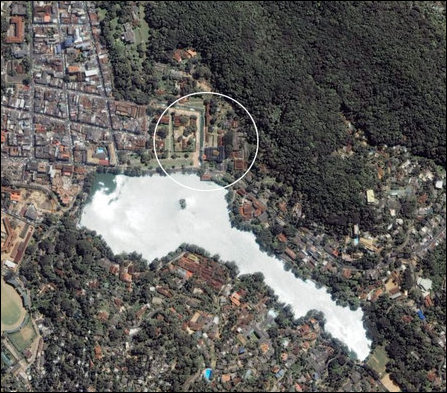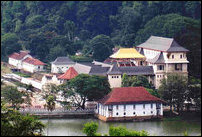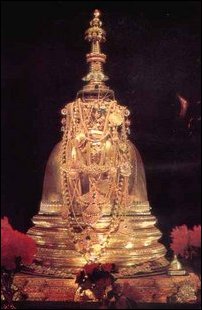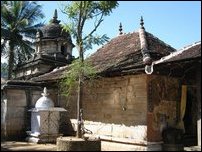Know the Etymology: 132
Place Name of the Day: Saturday, 01 August 2009
Kandy / Senkadagala / Mahanuwara
Kaṇḍi / Seṅkaḍagala / MahānuvaraKa'ndi
Cheng+kada+gala
Mahaa+nuvara
The enclosure / The red hill of difficult side / The great city
| Ka'ndi |
Sector, division, locality, quarters. A place name suffix mostly indicating a locality or a small area (Eezham Tamil); 75 acres of land (Tamil Lexicon); Kandiya: A Sinhala place name suffix similar in meanings to its Tamil usage; Kandi (Kandy): The name of the capital of the last kingdom of Ceylon; Kandam: A piece, portion (Changkam Tamil diction); Geographical divisions, country (old Tamil lexicons, Thivaakaram, Pingkalam and Choodaamani); Section, division, portion, block, boundary (Tamil usage and dictionaries); A division of the stretch of cultivation fields covered by a tank and divided on the basis of irrigation system (Vanni Tamil usage); Kandam, Ka'ndakam, Ka'ndaukam: Piece of of paddy field, a sector of land, a measure of land (Tamil inscriptions dated 923 CE, 1014 CE, 1008 CE and 1034 CE, Glossary of Tamil Inscriptions, pp 142-143); Kandi-adaiththal: Making an enclosure for fishing, the equipment is also called Kandi (Tamil fishermen usage, Winslow); Kaṇḍa: A portion or chapter (Pali / Prakrit); Kaṇṭa, Kaṇṭaka: The boundary of a village (Sanskrit); Kaaṇḍa: A part, portion, chapter, section (Sinhala); Kaṇḍana: Dividing, separating (Sinhala)
|
| Che |
Also Chem, Cheng, Chev, Chey, Chek etc in combinations: Red (Tamil, Malayalam, Changkam Diction and modern, Dravidian Etymological Dictionary 1931)
|
| Kadam |
Forest, hard and difficult path in a barren track (Tamil, Changkam diction, Dravidian Etymological Dictionary 1438); The side of a hill (Tamil, Pingkalam Lexicon 4:50); Suffix of names for hills having a difficult side (Tamil, Changkam diction, place names associated with hills in Tamil and Telugu); Thiru-veang-kadam: Thirupathi Hills (Tamil, Telugu); Gada: Stone, impediment, obstacle, fence, ditch, moat (Sinhala)
|
| Gala |
Stone, rock, hill (Sinhala); Kal: Same shades of meaning as in Sinhala (Tamil and other Dravidian languages, Dravidian Etymological Dictionary 1298). See columns on Galle, Bambaragala.
|
| Mahaa |
Great, big (Sanskrit, Prakrit,Tamil, Sinhala and other South Asian languages); Also, Maa: Great, big (Prakrit, Tamil, Sinhala)
|
| Nuwara |
Town, city, royal city, native name for Kandy (Sinhala, this form of the word is considered colloquial, Coloughs dictionary); Nagara: Town, city (Sanskrit, Prakrit); Nagara, Nagaraya, Nagaree: Town, city, equivalent to Nuwara (Sinhala); Nakar: House, temple, palace, town (Tamil, Changkam Diction); Nakaram: Town, palace, temple (Tamil, Changkam Diction); Nakar, Nakaram: Town, place name suffix (Modern Tamil); Nakari: A city, fortified town, metropolis, capital and also found in place names (Tamil, dictionaries and place names); Negeri: Town, city, capital (Malay); Nukarai: City, probably Kandy or some other city (a form found in Eezham Tamil literature, Vaiyaa Paadal: 77); Navarai: Town, found in the Tamil usage Thea-navarai (Gods Town) for the Sinhala place name Devi-nuwara (a form found in the Tamil part of the tri-lingual inscription of Galle)
|

Google Earth image of the city of Kandy. Note the Dalada Maligawa palace complex, the original part of the inner city of Kandy, between the hill and the lake.

The Dalada Maligawa (Temple of the Tooth Relic), Kandy [Photo courtesy: freewebs.com/lynseysmith copyright Lynsey Smith, 2004]

The casket containing the Tooth Relic [Photo courtesy: daladamaligawa.org]

Natha Devale, built in Dravidian architecture and dated to 13th century CE, is older than Dalada Maligawa and is the earliest structure found in Kandy today. The temple of the deity Natha (equated with Siva) is located in the complex facing Dalada Maligawa. The other temples in the complex are dedicated to Mahavishnu (Upulvan in Sinhala tradition), Paththini (Kannaki) and Kataragama Deviyo (Murukan). The last one is situated outside of the complex. Shrine of a folk deity or guardian demon, Dedi Munda (equated to southern Tamil Nadu folk cults of Mundan, Thadi Veeran and Munda Maadan) is also found attached to the Vishnu temple of the complex. Thadi Mundan in Tamil means a corpulent person. [Photo courtesy: Jamie Parkins, Barmy Army Descends, TravelPod, 2007]
Kandi, (in English, spelt Kandy and pronounced like the word candy), is the popularly used name for the capital of the last kingdom in the island of Sri Lanka. Today it is a major city of the island and is the capital of its Central Province. It is also considered as the sacred capital as being the seat of Dalada Maligawa, the temple of the Tooth Relic of Buddha.
Ever since the relics arrival from the Kalinga country (Orissa / Andra) in the 4th century CE to Anuradhapura, it was shifted from place to place whenever the capitals changed and Dalada Maligawa relic temples were built in all these capitals. The founder of the kingdom of Kandy, Vimaladarmasuriya brought it to Kandy in the late 16th century CE.
Kandi is an often-found suffix in the Eezham Tamil place names, meaning a locality, sector, quarters etc.
Kandiya found in the Sinhala place names is of equivalent shades of meaning. The toponymic meanings of these words are not found either in the Tamil or Sinhala dictionaries, but they are cognates of
Kaṇṭa / Kaṇṭaka in Sanskrit, meaning boundary of a village,
Kandam, found used in the
Changkam Tamil diction meaning a piece, portion etc (also meaning geographical divisions in the old Tamil lexicons) and
Kaṇḍa / Kaaṇḍa, meaning a part, portion, section, chapter etc in Pali / Prakrit / Sinhala. The word-form
Kandi is used in the Tamil fishermens dialect to mean enclosures made in shallow sea to catch fish.
The word
Kandi is also found in the place names of Tamil Nadu. Kandiyoor (Kandi-oor) near Thanjavur, mentioned in the Theavaaram hymns, is an example attesting to the antiquity of the usage of the word in Tamil toponyms at least since 7th century CE.
The toponym Kandy for the city under discussion seems to be only a few centuries old, as the old name for the place found in the records is Senkadagala.
Probably
Kandi in the context of this city meant the citadel part, the inner sector that was fortified or enclosed, housing palaces and temples. The native reference to the inner part of the capital, after its development into a city, probably became the toponym for the entire city in the colonial references. But note that it was the Tamil form
Kandi and not the Sinhala form
Kandiya that became popular in usage.
The old name Senkadagala (Cheng-kada-gala), originated from the landscape, means the red hill of the difficult side. All the components of this toponym are of Dravidian etymology.
The root word of the first component
Che/Se, which becomes
Seng/Cheng, Sem/Chem etc in compounds, means red (DED 1931). The word
Kadam (adjective:
Kada) that is often found in the names of hills stands for difficult terrain, side of a hill, etc (DED 1438). It shares similar shades of meaning in its Sinhala cognate
Gada. The third component
Gala is a cognate of
Kal, meaning stone, rock, hill etc., and is a popular suffix in toponyms associated with hills, rocky terrain etc. (DED 1298).
The location of the old part of the city of Kandy is adjacent to a difficult hill and the terrain is deep red in colour. Protection by the difficult hills determined the choice of the location for the capital.
An example for the occurrence of the component
Kadam in place names is Veang-kadam (also Thiru-veang-kadam), a toponym of much antiquity found in the
Changkam Tamil diction for Thirupathi.
Veang-kadam or
Veng-kadam simply means the hill having a barren and difficult side.
Mahaa Nuwara, which means the great city, is another name for Kandy that has found popular usage in Sinhala today.
Nuwara, according to Cloughs dictionary, is the colloquial Sinhala form of the word
Nagara that means a town or city in all South Asian languages.
Nuwara is found as a component in many old Sinhala place names. Interestingly, two equivalent forms are found in the Eezham Tamil literary and epigraphical usage: The word
Nuvarai was referring to a city in the 15th century Eezham Tamil historiographical literature,
Vaiyaa Paadal (verse 77) and the word
Navarai is found as a cognate of
Nuwara, in the Tamil part of the tri-lingual inscription of Galle, dated to early 15th century CE.
Some related place names: See column on
Polikandi for place names having the components Kandi and Kandiya
See columns on
Galle and
Bambaragala for place names having the component Gala
Cheng-koadu, Thiruch-cheng-koadu: The red hill. A place near Coimbatore in Tamil Nadu.
Cheng-kunram: The red hill. A place near Chennai.
Cheng-koaddai: The red fort. A place in the Tamil Nadu Kerala border.
Veang-kadam: Thiruppathi in Andra, bordering Tamil Nadu
Pennaa-kadam: A place near Viruththaasalam in Tamil Nadu.
Kadappaa: A place of difficult hills in Andra Predesh
Uda-nuwara and
Yati-nuwara: Upper and lower parts of the city. Localities of Kandy.
Alut-nuvara: The new town. A place in Gegalle district.
Devi-nuwara: The city of the deity. Presently called Dondra. In the Tamil part of the tri-lingual inscription of Galle the place was called Thea-navarai. Thea is deity in old Tamil.
First published: Saturday, 01 August 2009, 09:48










